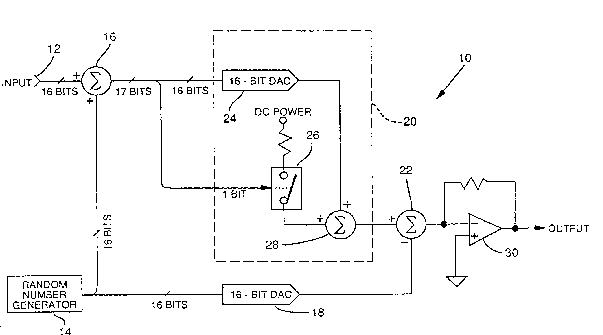Some of the information on this Web page has been provided by external sources. The Government of Canada is not responsible for the accuracy, reliability or currency of the information supplied by external sources. Users wishing to rely upon this information should consult directly with the source of the information. Content provided by external sources is not subject to official languages, privacy and accessibility requirements.
Any discrepancies in the text and image of the Claims and Abstract are due to differing posting times. Text of the Claims and Abstract are posted:
| (12) Patent Application: | (11) CA 2019237 |
|---|---|
| (54) English Title: | METHOD AND APPARATUS FOR LINEARIZING THE OUTPUT OF A DIGITAL-TO-ANALOG CONVERTER |
| (54) French Title: | METHODE ET DISPOSITIF POUR LINEARISER LE SIGNAL DE SORTIE D'UN CONVERTISSEUR NUMERIQUE-ANALOGIQUE |
| Status: | Deemed Abandoned and Beyond the Period of Reinstatement - Pending Response to Notice of Disregarded Communication |
| (51) International Patent Classification (IPC): |
|
|---|---|
| (72) Inventors : |
|
| (73) Owners : |
|
| (71) Applicants : |
|
| (74) Agent: | MARKS & CLERK |
| (74) Associate agent: | |
| (45) Issued: | |
| (22) Filed Date: | 1990-06-18 |
| (41) Open to Public Inspection: | 1991-05-27 |
| Examination requested: | 1997-05-09 |
| Availability of licence: | N/A |
| Dedicated to the Public: | N/A |
| (25) Language of filing: | English |
| Patent Cooperation Treaty (PCT): | No |
|---|
| (30) Application Priority Data: | ||||||
|---|---|---|---|---|---|---|
|
METHOD AND APPARATUS FOR LINEARIZING
THE OUTPUT OF A DIGITAL-TO-ANALOG CONVERTER
Abstract of the Disclosure
Distortion in a digital-to-analog converter (DAC)
is eliminated by adding a digital random number to
each sample of the digital signal, converting the sum
into analog form, and subtracting from this analog sum
the analog counterpart of the digital random number.
The result is the analog counterpart to the input
digital signal. The conversion of the summed digital
signal and the random number into analog form can be
performed by two conventional DACs. For any digital
input sample, the output of each DAC is equally likely
to contain any of the possible distortion errors
produced by that DAC. (An exception is the most
significant output bit of the DAC that processes the
summed signal, an exception that may be handled by
stripping off the most significant bit and applying it
to a one bit DAC.) The error signal at the output of
each of the two DACs is thus a random sequence (i.e.
noise) of DAC distortion errors. The time average of
this noise signal is a small offset error which, if
desired, can be removed by subsequent processing
stages.
Note: Claims are shown in the official language in which they were submitted.
Note: Descriptions are shown in the official language in which they were submitted.

2024-08-01:As part of the Next Generation Patents (NGP) transition, the Canadian Patents Database (CPD) now contains a more detailed Event History, which replicates the Event Log of our new back-office solution.
Please note that "Inactive:" events refers to events no longer in use in our new back-office solution.
For a clearer understanding of the status of the application/patent presented on this page, the site Disclaimer , as well as the definitions for Patent , Event History , Maintenance Fee and Payment History should be consulted.
| Description | Date |
|---|---|
| Inactive: IPC from MCD | 2006-03-11 |
| Inactive: IPC from MCD | 2006-03-11 |
| Application Not Reinstated by Deadline | 2001-12-31 |
| Inactive: Dead - No reply to s.30(2) Rules requisition | 2001-12-31 |
| Deemed Abandoned - Failure to Respond to Maintenance Fee Notice | 2001-06-18 |
| Inactive: Abandoned - No reply to s.30(2) Rules requisition | 2000-12-29 |
| Inactive: S.30(2) Rules - Examiner requisition | 2000-06-29 |
| Letter Sent | 2000-06-22 |
| Letter Sent | 2000-06-22 |
| Inactive: Multiple transfers | 2000-04-20 |
| Inactive: Multiple transfers | 2000-04-20 |
| Inactive: Correspondence - Formalities | 2000-03-08 |
| Amendment Received - Voluntary Amendment | 1999-05-20 |
| Inactive: S.30(2) Rules - Examiner requisition | 1999-02-25 |
| Inactive: Correspondence - Formalities | 1999-02-09 |
| Inactive: Status info is complete as of Log entry date | 1997-10-09 |
| Inactive: Application prosecuted on TS as of Log entry date | 1997-10-09 |
| Inactive: Delete abandonment | 1997-10-09 |
| Inactive: Abandon-RFE+Late fee unpaid-Correspondence sent | 1997-06-18 |
| All Requirements for Examination Determined Compliant | 1997-05-09 |
| Request for Examination Requirements Determined Compliant | 1997-05-09 |
| Application Published (Open to Public Inspection) | 1991-05-27 |
| Abandonment Date | Reason | Reinstatement Date |
|---|---|---|
| 2001-06-18 |
The last payment was received on 2000-06-09
Note : If the full payment has not been received on or before the date indicated, a further fee may be required which may be one of the following
Patent fees are adjusted on the 1st of January every year. The amounts above are the current amounts if received by December 31 of the current year.
Please refer to the CIPO
Patent Fees
web page to see all current fee amounts.
| Fee Type | Anniversary Year | Due Date | Paid Date |
|---|---|---|---|
| Request for examination - standard | 1997-05-09 | ||
| MF (application, 7th anniv.) - standard | 07 | 1997-06-18 | 1997-06-03 |
| MF (application, 8th anniv.) - standard | 08 | 1998-06-18 | 1998-06-02 |
| MF (application, 9th anniv.) - standard | 09 | 1999-06-18 | 1999-06-15 |
| Registration of a document | 2000-04-20 | ||
| MF (application, 10th anniv.) - standard | 10 | 2000-06-19 | 2000-06-09 |
Note: Records showing the ownership history in alphabetical order.
| Current Owners on Record |
|---|
| AGILENT TECHNOLOGIES, INC. |
| Past Owners on Record |
|---|
| RAYMOND C. BLACKHAM |